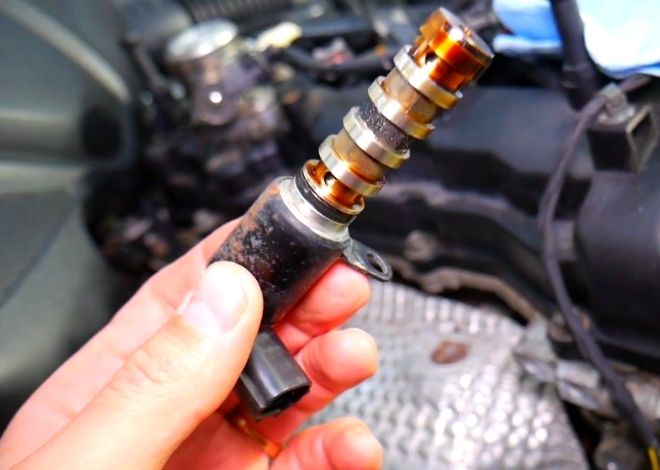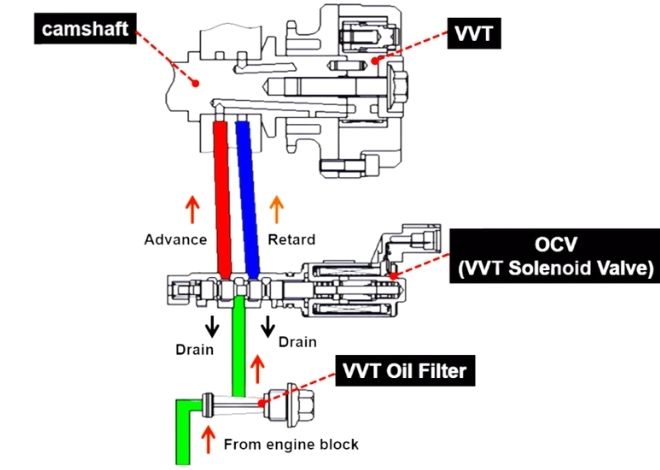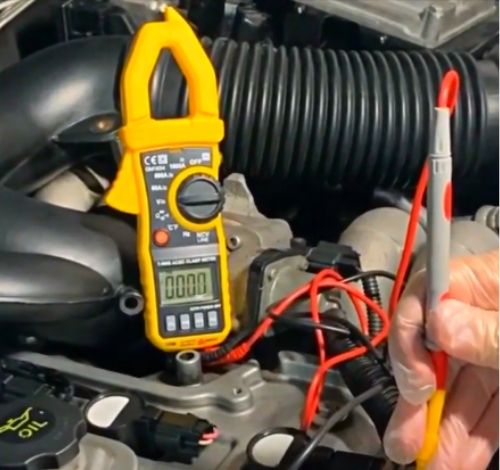Last Updated on April 22, 2025
What Does Code P0014 Mean?
If you’re a car owner, you’ve likely experienced moments of frustration when the dreaded check engine light appears. Among the various OBD-II trouble codes, one that frequently puzzles drivers is P0014. This diagnostic trouble code (DTC) can cause performance issues and indicate more serious underlying problems.
The P0014 code stands for “B” Camshaft Position – Timing Over-Advanced or System Performance (Bank 1). In simpler terms, this means that the exhaust camshaft on bank 1 is more advanced than it should be, according to the values expected by the powertrain control module (PCM). This over-advancement can result from problems in the variable valve timing (VVT) system, oil-related issues, or even a malfunctioning camshaft sensor.
This issue primarily relates to the rotational misalignment of the camshaft, which affects engine timing and performance. Addressing it promptly is crucial to avoid more expensive repairs down the line.
Quick Causes for Trouble Code P0014
Here are the most common causes of the P0014 trouble code:
- Faulty camshaft position sensor
- Low or dirty engine oil
- Oil flow restrictions to or from the camshaft-phasers
- Worn or broken timing chain/belt
- Defective Variable Valve Timing (VVT) solenoid
- Faulty Engine Control Module (ECM)
Quick Solutions for Trouble Code P0014
Here are some practical solutions that can help resolve the P0014 code:
- Replace the camshaft position sensor
- Perform an engine oil change or top-up
- Clean or remove blockages in oil passages
- Inspect and repair the timing chain/belt
- Replace the VVT solenoid
- Test and reprogram or replace the ECM, if needed
Common Vehicle Models Affected by P0014
Several popular car models frequently display this error. You may come across:
- P0014 Chevy Equinox
- P0014 Trailblazer
- P0014 GMC Envoy
- Hyundai P0014
- P0014 Chevy Malibu
- Buick Enclave P0014, and more
Possible Causes of the DTC P0014

Let’s dive deeper into the root causes that could trigger this camshaft timing issue:
1. Sludge or Dirty Oil
The most common reason behind the P0014 code is sludge buildup in the engine oil. Over time, old or poor-quality oil can break down and leave behind debris. This debris clogs oil passages and affects the camshaft actuator’s ability to operate correctly.
Also, using the wrong viscosity oil can cause circulation issues, especially in colder climates. Low oil levels can also disrupt oil pressure, which is vital for the functioning of the VVT system.
2. Faulty VVT Solenoid
The Variable Valve Timing solenoid regulates the oil flow to the camshaft phasers based on engine load and RPM. When this component fails, it affects timing precision, leading to over-advanced camshaft positioning.
Signs of a faulty solenoid include engine hesitation, poor acceleration, and increased emissions. If left unchecked, it could lead to severe engine damage.
3. Camshaft Phaser Malfunction
The camshaft phaser is a crucial part of the VVT system, responsible for adjusting the camshaft position. A dislocated or damaged phaser causes incorrect timing and may result in the P0014 code. These phasers are electronically controlled and can be damaged by low oil pressure or contaminated oil.
4. Oil Flow Disruption
A continuous and clean oil supply is necessary for the VVT system to function. If there’s oil starvation or blockage, the camshaft can’t rotate as intended. Check for oil pump failure, clogged oil passages, or worn-out seals that could cause this problem.
5. PCM Software or Electrical Fault
Sometimes, the issue isn’t mechanical but electrical or software-related. A glitch in the PCM (Powertrain Control Module) or corrupted firmware might misinterpret camshaft timing data. Updating the PCM’s software or resetting the ECU can fix the issue if no physical damage is found.
6. Wiring and Connector Issues
Faulty wiring in the valve control solenoid circuit can cause false signals to be sent to the ECM. This may result in incorrect interpretation of the camshaft’s position. Always inspect and secure loose, damaged, or corroded wiring around the camshaft sensor and solenoid.
Symptoms of Trouble Code P0014
Wondering how to detect the P0014 fault code early? Here are the most telling signs. Recognizing these symptoms early can save you from extensive repairs later:
1. Difficulty Starting the Engine
One of the most frequent symptoms is difficulty in starting the vehicle. A misaligned camshaft results in improper air-fuel mixture and timing, which disrupts the ignition sequence. The car might crank but fail to start, or start and then immediately shut down.
2. Limp Mode Activation
Modern vehicles have a limp or fail-safe mode to protect the engine from further damage. If the system detects the camshaft timing is dangerously off, it limits engine power and activates this mode. You may notice sluggish acceleration and reduced RPM limits.
3. Decreased Fuel Economy
When timing is off, combustion becomes inefficient. This results in increased fuel consumption. If you’re visiting the gas station more often without a change in driving habits, a trouble code like P0014 could be the reason.
4. Increased Emissions and Exhaust Smoke
An over-advanced camshaft leads to poor combustion, which can cause black or white smoke from the tailpipe. This is a sign that the fuel isn’t burning efficiently, and your vehicle may also fail emissions tests.
5. Engine Rattling or Ticking Noise
A misaligned camshaft may cause rattling or ticking noises from the top of the engine, especially during a cold start. These noises are caused by timing chain slap or improper valve timing, often pointing to damage in the VVT mechanism or phasers.
6. Rough Idling or Vibrations
If the camshaft timing is incorrect, the engine may struggle to maintain a smooth idle. You may experience rough idling, shaking, or vibrations, especially at lower speeds or while stopped.
How to Diagnose Error Code P0014?
Have you encountered error code P0014 on your vehicle? If not yet, knowing how to diagnose it will save you both time and money in the future. Diagnosing P0014 (Camshaft Position Timing Over-Advanced or System Performance Bank 1) can be a complex and sometimes expensive process if not approached correctly. This error code usually indicates issues with the camshaft timing, particularly with the Variable Valve Timing (VVT) system, which can affect your engine’s performance significantly.
Step-by-Step Diagnosis Process
- Start With an OBD-II Scanner Use a reliable OBD-II scanner to check for trouble codes. Plug the scanner into your vehicle’s OBD port—usually located beneath the steering wheel—and run a scan. Take note if other codes appear along with P0014, such as P0011 or P0024. These may provide additional clues about the underlying issue.
- Check Engine Oil Level and Condition Low or dirty engine oil is one of the most common culprits behind code P0014. Inspect the oil level and quality. Old, sludgy, or incorrect viscosity oil can prevent the VVT solenoid from functioning properly. If necessary, perform an oil change with the manufacturer-recommended oil type and viscosity.
- Inspect the Variable Valve Timing (VVT) Solenoid The VVT solenoid is responsible for regulating the oil flow to the camshaft phaser. Use a multimeter to check for proper voltage and resistance. You can also remove and clean the solenoid if it’s clogged, or replace it if it’s malfunctioning.
- Examine Camshaft and Crankshaft Sensors Faulty sensors can send incorrect data to the PCM (Powertrain Control Module), triggering the error. Ensure both sensors are clean, properly connected, and functioning.
- Analyze Timing Components The next area to focus on includes:
- Timing belt/chain
- Gears and sprockets
- Tensioners and guides
Wear or slack in these parts can cause timing to be off, which directly affects the VVT operation. Misalignment or tooth damage is a red flag.
- Check the PCM (Powertrain Control Module) In some cases, a software-related fault or outdated programming in the PCM may be responsible. Consider performing a PCM update or reprogramming as recommended by your vehicle manufacturer.
- Evaluate the Oil Control Valve (OCV) The OCV regulates oil flow to the VVT mechanism. Ensure it isn’t stuck open/closed, leaking, or corroded.
Pro Tip:
Always record freeze-frame data before clearing the code. It will help you analyze under what conditions the error occurred, making the root cause easier to pinpoint.
How to Fix Trouble Code P0014?
Fixing error code P0014 isn’t just about clearing the code—it’s about addressing the root cause to prevent recurrence. Here’s a breakdown of the repair process:
1. Engine Oil Change
Replace dirty or degraded engine oil and use the correct oil viscosity. A high-quality synthetic oil is often recommended for engines using VVT systems.
2. Replace or Clean VVT Solenoid
A faulty VVT solenoid can’t control the camshaft timing correctly. Clean it with an appropriate solvent or replace it if it’s malfunctioning.
3. Repair or Replace Damaged Timing Components
Timing belt or chain issues can directly affect camshaft position. If you notice wear, broken teeth, or slack, replace the belt/chain and any affected components.
4. Replace Oil Control Valve (OCV)
If clogged or rusted, replace the oil control valve with a compatible OEM part. A damaged OCV can fail to regulate oil flow, triggering timing issues.
5. Fix Electrical Wiring
Inspect all connectors, terminals, and wires related to the camshaft position sensor, crankshaft position sensor, VVT solenoid, and PCM. Fix corrosion or broken wires immediately.
6. Update PCM Software
If all physical parts are functioning, a PCM software glitch might be the issue. Flash or update the PCM using manufacturer-approved software.
7. Reset the Code and Test Drive
After making the necessary repairs, use the OBD-II scanner to clear the code. Take the vehicle on a 15–20-minute test drive to ensure the code doesn’t return and to confirm the engine is performing normally.
How Serious Is the P0014 Code?
The P0014 trouble code is not one to ignore. If left unresolved, it can result in:
- Poor fuel economy
- Engine stalling or hard starting
- Rough idling and decreased power
- Severe engine damage due to incorrect valve timing

In extreme cases, the engine can suffer catastrophic failure, especially if the timing chain slips or the valves contact the pistons. Immediate attention is strongly recommended.
Common P0014 Diagnosis Mistakes
Avoiding common diagnostic mistakes can help you solve the issue more effectively. Here are a few to be aware of:
- Ignoring the Oil Quality
Many mechanics overlook old or low-quality oil, even though it’s one of the top causes of this code. - Overlooking Timing Components
Failure to inspect timing chain, sprockets, or guides can result in missed diagnoses. - Skipping Manufacturer-Specific Procedures
Vehicle manufacturers often provide model-specific test sequences or guidelines. Ignoring these can lead to incorrect repairs. - Not Checking Related Codes
Multiple DTCs may appear together. Fixing just one without addressing the others may not resolve the root issue.
Recommended Tools for Diagnosing P0014
You’ll need the following tools to properly diagnose and repair P0014:
- OBD-II Scanner with freeze-frame capability
- Multimeter or test light
- Basic hand tools (screwdrivers, wrenches, sockets)
- Fused jumper wires
- Vehicle-specific repair manual
- Oil pressure gauge (optional but helpful)
- Replacement engine oil and filter
Having these tools on hand will ensure a smoother diagnostic and repair process.
What Is the Estimated Cost of Repair?
Repair costs for P0014 can vary widely depending on the root cause and vehicle make. Here’s a general breakdown:
| Repair Task | Estimated Cost |
|---|---|
| Engine Oil & Filter Change | $40–$60 |
| VVT Solenoid Replacement | $300–$400 (parts & labor) |
| Oil Control Valve (OCV) Replacement | $150–$250 |
| Timing Chain/Belt Replacement | $500–$1,200 |
| PCM Reprogramming | $100–$250 |
| Complete Engine Replacement (if damaged) | $3,000–$4,500+ |
Labor costs may also vary based on your location and the auto repair shop’s hourly rate. Always get multiple estimates before authorizing expensive repairs.
Preventive Tips to Avoid P0014 Code
Preventing P0014 can save you hundreds—or even thousands—of dollars. Here’s how:
- Use only manufacturer-recommended engine oil and change it regularly.
- Inspect and replace your timing chain or belt at recommended intervals.
- Don’t ignore rough idling or sudden drops in fuel efficiency.
- Perform regular engine diagnostics with an OBD-II scanner.
- Follow scheduled maintenance in your owner’s manual.
Final Words
The P0014 code can lead to serious engine issues if left unresolved. While fixing it may seem intimidating, it becomes much easier when you follow a structured diagnostic approach. Start with basic checks like engine oil and move toward more advanced diagnostics like solenoid and timing system inspection.
If you’re uncertain or lack tools, always consult a certified technician to avoid costly mistakes. By acting early and smartly, you can restore your vehicle’s performance, extend its lifespan, and prevent future breakdowns.
Kevin Nicholas is an automotive technician who is a genius at software and hardware-related issues. He manually tested more than a hundred OBD scanners and gave his honest opinion on whether the device was worth the money or not. His in-depth OBD review articles help people choose the right product, whether it is a European, American, or Asian vehicle. He completed his Automotive Specialized Training Course at Universal Technical Institute and has more than 15 years of experience in the field.
